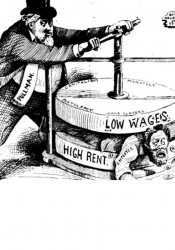The Pullman Strike of 1894
The Pullman Strike was an organized railroad strike against Pullman Palace Car Company in Chicago between May and July, 1894. (Urofsky, Britannica) It began after the owner of the company, George Pullman, reduced wages during the 1893 depression, while also retaining the high cost of living in his worker town of Pullman, IL. Workers complained that they were unable to feed their families after paying for rent even before the reduced wages. The first six weeks of the strike were kept fairly tame, and the media kept quiet on the issue. However, on June 28th, after Pullman’s failure of an arbitration, the American Railway union was ordered not to handle any Pullman cars, or any trains pulling Pullman cars. By June 30th, over 125,000 workers on 29 railroads had quit work. What followed was an awakening to the American people on just how strong of an impact the railway system has on their economic system.
George Pullman attempted to call on the local militia to counteract the strike, but the militia was found uncapable of the scale of rioters. After a failure to legislate the movement of federal mail through the railways, President Grover Cleveland issued troops from multiple surrounding forts involving nearly 4,000 troops. (Chicagology) Violence continued to ensue as the troops planted themselves across Chicago where riots were taking place. On July 6, a group of 6,000 rioters destroyed hundreds of railcars. The next day, with a force of an estimated 6,000 troop, the counter-strike force opened fire on a crowd in reaction to being attacked. Thirty people were killed & many more were wounded, the leader of the strike, Eugene Debs, called for an end to the strike the next day. He requested that all the non-criminal employees be rehired by The Pullman Company, who agreed and reopened on August 2. Not all workers were re-hired however, as a Boston newspaper, Banner of Light printed that an estimated 1500 families would be evicted from Pullman, IL to be replaced by new workers. Despite much of the public losing faith in the union after all the violence and economic disturbance by the strike, the article printed, “The laboring men and mechanics have always been the backbone of every nation thus far, and, as Goldsmith wrote so long ago: ‘Ill fares the land to hast’ning ills a prey, where wealth accumulates, and men decay.’” (Banner of Light)
As Amazon continues to push their labor force, with a turnover rate over 100%, and an employment number over 600,000, 2021 marked the first time they would be opening Amazon Towns for their employees. (Ashford, Kantor, & Weise, New York Times) The Great Resignation seems to be a continued response to the horrifying potential of history repeating itself. George Pullman was considered a robber baron of his time, and Jeff Bezos undoubtedly continues the tradition of abusing workers to the fullest extent of the law, and then some. The wealth gap is the highest its ever been in recorded history, and the Pullman Strike of 1894, which eventually would inspire a national holiday – Labor Day – is a haunting reminder of what happens when workers are pushed to their physical and economic limit.
Related Links:
The Stonewall Riots - Similar to the Pullman Strike, The Stonewall Riots brought the issue to the front of the news. Before Stonewall & Pullman, people were not as concerned with the happenings of gay people and poor laborers respectively. The violence that was used against the strikers and rioters shall never be forgotten. Both events became historical too, as the Pullman Strike granted America Labor Day, while Stonewall became a beacon for gay rights & its public power.
The Black Panthers - The Black Panthers were a response to the rising tension of the Civil Rights movement, and Dr. Martin Luther King's approach to non violent protests. Instead of being non-violent, the Black Panthers began arming themselves and teaching their families and friends how to be more reliant on black communities instead of the established white one. Like the Pullman Strike, the government paid extra attention to the Black Panther party, and responded accordingly when they thought they were stepping out of line; The groups were marginalized and fought against by the American government.
Work Cited:
“1894- Pullman Strike & Labor Day”. Chicagology. April 29, 2021. Retrieved from: https://chicagology.com/notorious-chicago/1894pullmanstrike/
Chicago Labor Newspaper. “Political Cartoon of the Gilded Age,” The Making of the Modern U.S., accessed April 29, 2022, from: http://projects.leadr.msu.edu/makingmodernus/items/show/288
Grace Ashford, Jodi Kantor & Karen Weise. "Inside Amazon's Employment Machine". New York Times. June 21, 2021. Retrieved from: https://www.nytimes.com/interactive/2021/06/15/us/amazon-workers.html
“The Outcome of the ‘Pullman’ Strike is that the strikers and their dependents”. American Historical Periodicals. Banner of Light. Aug 18, 1894. Vol 75, Iss 24, Pg 4
Urofsky, Melvin l., et al. “Pullman Strike”. Britannica. Aug 25 2021. Retrieved from: https://www.britannica.com/event/Pullman-Strike

